High-impact and student-centered pedagogies create educational environments that encourage students to be active, responsible participants in their own learning. A growing body of research demonstrates that participation in learning practices such as the ones listed below increases rates of student engagement and improves course effectiveness and outcomes for all learners. Research also shows that such practices often improve retention, narrow achievement gaps for underrepresented minority students, and help create learning environments that are more inclusive and accessible to students with diverse backgrounds and learning styles.
Many different types of learning activities can be considered “high-impact” and/or “student-centered.” This guide focuses on teaching and learning strategies that can be implemented at the level of an individual course. In practice, many of the strategies outlined below work well when employed in tandem. See the Bibliography section below for more information about peer-reviewed papers and other research studies exploring the benefits of these approaches.
Contact the Center for the Advancement of Teaching team at consult@teaching.ucla.edu to schedule a consultation about any of these teaching strategies.
Active Learning
Active learning is generally defined as “instructional activities that involve students doing things or thinking about what they are doing” (Bonwell and Eison, 1991). This pedagogical strategy can involve a wide range of activities, including guided discussion, use of polling tools, problem solving, case studies, role playing, debate, project-based learning, or other methods. Many of these approaches are discussed in more detail below.
Active learning activities vary widely both in duration (from a few minutes to an entire class period or longer) and in the amount of effort involved on the part of students and instructors. Many resources are available within and beyond UCLA to support instructors interested in developing active learning opportunities for students:
UCLA Center for the Advancement of Teaching offers consultations about active learning techniques, and about making the most of UCLA’s active learning classrooms. CAT has also developed a guide for adapting active learning strategies for remote instruction.
UCLA Center for Education, Innovation, and Learning in the Sciences (CEILS) offers a general guide to interactive learning techniques, as well as a specialized guide on effective use of polling tools to foster interactiivty – The first guide provides an overview of active learning, as well as an introduction to several techniques especially suitable for STEM classes, and a helpful index of active learning techniques by effort. The second guide provides strategies for success with polling technology (iClicker and other digital tools) as well as an introduction to tech-free polling tools.
Queens University’s open-access module on active learning – This resource from Queens University provides an overview of active learning and evidence that supports the effectiveness of the pedagogy, as well an introduction to specific active learning activities and supplemental resources for instructors. The site includes an index of websites with sample activities, and an archive of videos featuring experienced instructors from a variety of disciplines discussing specific activities they have used, as well as challenges and tips for success using active learning in small, medium, large, and online classes.
Case Method
Teaching with the case method involves presenting students with a rich narrative in which individuals or groups must make decisions based on evidence. When presented as active learning activities, cases typically do not provide students with a solution to the problem. Instead, students use the information provided to work (individually or in teams) to analyze the evidence presented, assess the positions of stakeholders, evaluate options, and predict the outcomes of particular choices. For longer in-class activities and assignments, students can also be asked to assume the position of a particular stakeholder and argue for a particular solution or engage in a debate with peers representing other positions.
For additional information and sample cases, visit the websites and case archives listed below. Many of these sites allow users to search for cases and teaching tools by discipline as well as topic. For assistance incorporating the case method into your teaching, contact us at CAT for a consultation.
Pedagogy in Action: https://serc.carleton.edu/sp/library/cases/index.html This site provides a helpful overview of the case method. While affiliated with Carleton College’s Science Education Resource Center (SERC), cases included in the site’s database come from a range of fields.
Harvard Kennedy School of Government: https://case.hks.harvard.edu/teaching-with-cases/ Case collections on this site focus mainly on issues facing public and nonprofit sectors, but the teaching tips and video demonstrations will be relevant to instructors in any field.
UC Santa Barbara Case Method: http://casemethod.projects.soc.ucsb.edu/intro.html This site includes resources to support instructors interested in leading case discussions, as well as a library of cases focused primarily on political science, international relations, and related fields.
National Center for Case Study Teaching in Science: http://sciencecases.lib.buffalo.edu/cs/collection/ This site offers a large library of peer-reviewed cases in a range of fields within and beyond STEM disciplines. Teaching notes and answer keys are available to members (membership requires contribution of a case to the archive, participation in the peer review process, or an annual fee).
Collaborative Learning
According to the American Association of Colleges and Universities (AAC&U) collaborative learning “combines two key goals: learning to work and solve problems in the company of others, and sharpening one’s own understanding by listening seriously to the insights of others, especially those with different backgrounds and life experiences. Approaches range from study groups within a course, to team-based assignments and writing, to cooperative projects and research.” Many resources are available within and beyond UCLA to support instructors interested in developing collaborative learning opportunities for students:
UCLA Center for the Advancement of Teaching consultations on collaborative learning
UCLA Center for Education, Innovation, and Learning in the Sciences (CEILS) guide for designing effective group work
UCLA Excellence in Pedagogy and Innovative Classrooms (EPIC) guide to collaborative learning
Vanderbilt University guide for using cooperative groups effectively
Carnegie Mellon University guide for assessing group work
Community-Engaged Learning
UCLA’s approach to community-engaged teaching and learning draws heavily on the Carnegie Foundation’s definition of community engagement as “teaching, learning, and scholarship that engages faculty, students, and community in mutually beneficial and respectful collaboration. Their interactions address community-identified needs, deepen students’ civic and academic learning, enhance community well-being, and enrich the scholarship of the institution.”
Community-engaged teaching can take many different forms depending on the learning goals for a particular course, the departmental context, and the aims of the community partnership. UCLA faculty currently employ the following strategies in their community-engaged teaching (this list is not exhaustive):
- Community-Engaged Research – Students apply their academic skills to conduct research in collaboration with one or more community partners.
- Client Consulting – Students apply the skills of their discipline to address needs or challenges identified by community stakeholders.
- Co-Learning – Students and community constituents learn together in courses based at UCLA or in a community location in Los Angeles or through travel study programs.
- Co-Creating – Students and community constituents engage in creative or artistic work together based at UCLA or in a community location.
- Service Delivery – Students support the delivery of programs or services to constituents being served by a community organization.
- Capacity Building – Students work to support the mission of a community organization through activities such as curriculum development, translation services, website design, and data analysis.
- K-12 and Community Education – Students develop and lead lessons in school-based, after school, or community programs.
- Internships – Students typically apply for internships on an individual basis, and enroll in an independent study course either directly through their department or through the Center for Community Engagement.
For assistance developing a community-engaged course at UCLA, contact the Center for Community Engagement.
For additional information about community-engaged pedagogy, consult the following resource hubs:
- Association of American Colleges & Universities — including their Bringing Theory to Practice and Civic Learning and Democratic Engagement initiatives
- Campus Compact — including their The Research University Civic Engagement Network (TRUCEN)
- Imagining America: Artists & Scholars in Public Life
Problem-Based Learning
Problem-based learning encourages students to think critically and creatively about complex problems drawn from real situations. By working indivually or in teams to solve problems, students learn how to develop and test hypotheses, generate prototypes, and evaluate interpretations of evidence. While problem-based learning is often employed to help students develop quantitative reasoning skills, particlualry in STEM disciplines, this approach to inquiry can also be applied in the arts, humanities, and social sciences. For assistance incorporating problem-based learning into your teaching at UCLA, contact CAT to schedule a consultation.
The resources collected below provide additional information about problem-based learning:
University of Delaware’s Problem-Based Learning Clearinghouse – This site includes an overview of problem-based learning, as well as an archive of problem statements from a wide range of disciplines.
Stanford’s Design Thinking Bootleg – This website and downloadable resource guide introduce educators to the core principles of design-thinking, including strategies for prototyping and testing projects in a range of disciplines.
Project-Based Learning
According to the Buck Insitute for Education, project-based learning allows students to invest significant time in investigating and responding to an authentic, engaging, and complex question, problem, or challenge. Students typically work in teams to develop and execute a work plan, which often culminates in a public demonstration or presentation. For assistance incorporating project-based learning into your teaching at UCLA, contact CAT to schedule a consultation.
The resources collected below provide additional information about project-based learning:
Worcester Polytechnic University’s Center for Project-Based Learning – This center offers a wide range of online resources to support project-based pedagogy, and hosts an annual Institute on Project-Based Learning, as well as custom workshops and seminars.
The Buck Institute for Education’s PBLWorks resource hub – This site provides resources to support project-based learning at all levels, from K-12 through college.
Bibliography: Key Education Research on High-Impact and Student Centered Learning
Association of American Colleges & Universities High-Impact Practices Report: https://www.aacu.org/leap/hips
Bonwell, Charles C. and James A. Eison. Active Learning: Creating Excitement in the Classroom. ASHE-ERIC Higher Education Reports. 1991.
Davidson, Neil and Claire Howell Major. “Boundary Crossing: Cooperative Learning, Collaborative Learning, and Problem-Based Learning.” Journal on Excellence in College Teaching, vol. 25, no. 3-4, 2014, pp. 7-55.
Dolgon, Corey, Tania D. Mitchell, and Timothy K. Eatman, Eds. The Cambridge Handbook of Service Learning and Community Engagement. Cambridge, UK: Cambridge University Press, 2019.
Mello, David and Colleen A. Less. “Effectiveness of active learning in the arts and sciences” Humanities Department Faculty Publications & Research, vol. 45, 2013.
National Survey of Student Engagement High-Impact Practices Report: http://nsse.indiana.edu/html/high_impact_practices.cfm
Petersen, Christina I. and Gorman, Kristen S. “Strategies to Address Common Challenges When Teaching in an Active Learning Classroom.” New Directions for Teaching and Learning, vol. 137, 2014, pp. 63-70.


